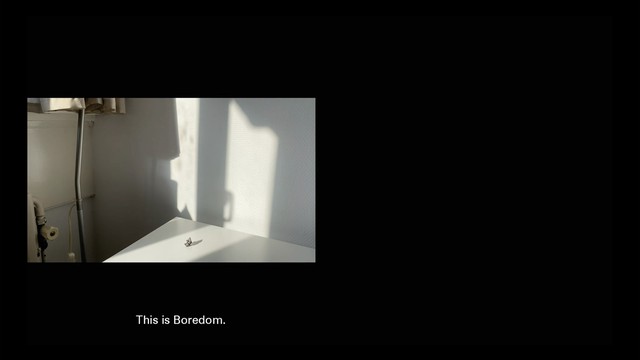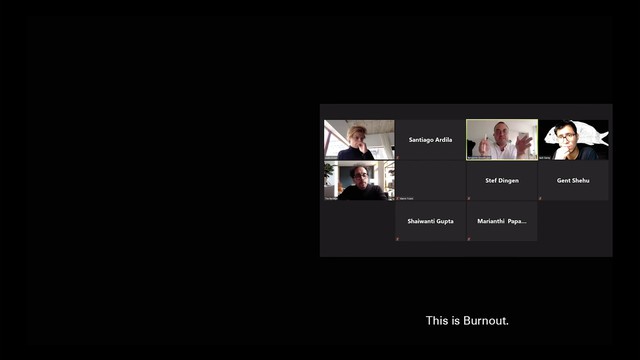Boredom and burnout 2020, Netherlands, Delft
Space of the bedroom and its blurring boundaries.






‘Boredom and Burnout’ confronts the relation of Space, Quarantine and Architecture documenting snippets of real time experiences in the first lock-down of 2020. Isolation and social distancing in COVID-19 pandemic made the intrusion of media in our daily lives even more evident. Boredom and burnout are two contradictory emotions that enter the domestic space. They co-exist in this generative space where distance is shortened, information is plenty but the spatial boundaries between work and leisure are entirely mitigated.
‘Boredom and Burnout’ confronts the relation of Space, Quarantine and Architecture documenting snippets of real time experiences in the first lock-down of 2020. Isolation and social distancing in COVID-19 pandemic made the intrusion of media in our daily lives even more evident. Boredom and burnout are two contradictory emotions that enter the domestic space. They co-exist in this generative space where distance is shortened, information is plenty but the spatial boundaries between work and leisure are entirely mitigated. Private spheres and public spheres have merged together through digital technologies. With social distancing and lockdowns more screens and workstations have moved from the formal setting of offices to the intimate space of the bedroom. Public sphere has become a virtual or imaginary community which necessarily does not exist in any identifiable space. The ideal rhythmic balance between intensive work and leisure is perplexed with no physical disconnect. Exhaustion prevails over regeneration. In the post-war period, the bedroom had witnessed a similar evolution of space with the introduction of television. TV not only changed the configuration of furniture but also regulated the cycle of time. The time we fall asleep watching television to ways in which the day was planned. The difference however being the physical distinction between intimate spaces and formal spaces. In 2020 conversely, with domestic isolation and work-from-home scenarios, we are forced to sleep where we work with no in between space for decompression. We have turned the domesticated private space into our labor space. Remote connection that is immediately available, accessible and utilizable has produced 24-hour work cycle and extensive use of multiple screens. Creating an environment where information is plenty and the living space is condensed. This results in contradictory emotional conditions, the least tragic but perhaps the most common: boredom and burnout. The video essay thus begins to question, where in the spatial configuration of everyday architecture does boredom and burnout find their place? Can they find an equivalent projection in our homes or be rooted to the blurring programmatic boundaries? If media is the catalyst of this changing space, can space be regulated to balance this emotional distortion?
https://spacetelevisionandarchitecture.nl/Boredom-and-Burnout
Poster
Details
Team members : Shaiwanti Gupta and Santiago Ardila
Supervisor : Salomon Frausto and Léa-Catherine Szacka
Institution : The Berlage Center for Advanced Studies in Architecture and Urban Design
Funding agencies : Self-funded
Partners : TU Delft
Descriptions
Technical Concept : The film was shot from the domestic confinement of two rooms. Where one focussed on the extremity of work and zoom meetings resulting in burnout, the other explored the idleness generating boredom from being imprisoned in a confined space. The film was divided in five scenes exploring: ‘The Self’ – the space between the outside and inside - the inner world, ‘The Bedroom’ – an evolving connotation, ‘The Office’ – a mutating mobile space, ‘The Thresholds’ – spatial projections of these emotions, and ‘Non-stop Screens’ - space between time-frames mediating the new generative space.
Visual Concept : Two frames of boredom and burnout are placed on the screen. The split- screen simultaneously portrays two interactions of the same spatial environment - the bedroom. Two voices speak of the implication of each. The contradictory emotions exist in parallel and highlight the internal confusion of merging spaces. Becoming dull and nerve-wracking at the same time the issues of programmatic shift mediated though abundance of media and screens is brought to surface.
Credits
The Berlage Center for Advanced Studies in Architecture and Urban Design
The Berlage Center for Advanced Studies in Architecture and Urban Design
The Berlage Center for Advanced Studies in Architecture and Urban Design
The Berlage Center for Advanced Studies in Architecture and Urban Design
The Berlage Center for Advanced Studies in Architecture and Urban Design
The Berlage Center for Advanced Studies in Architecture and Urban Design
The Berlage Center for Advanced Studies in Architecture and Urban Design